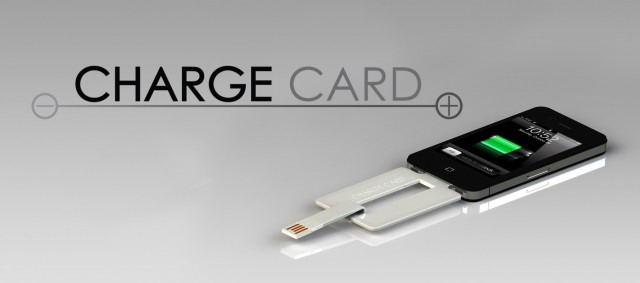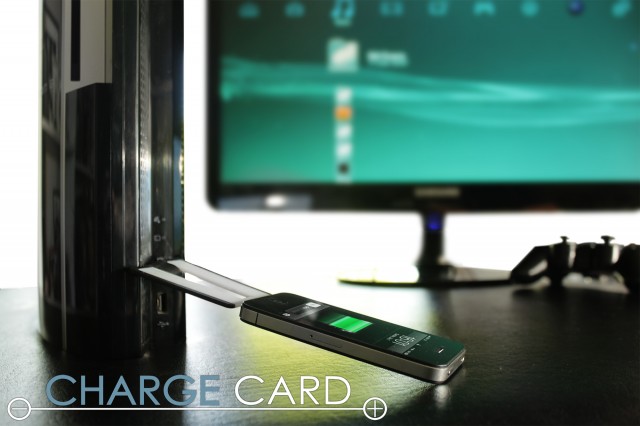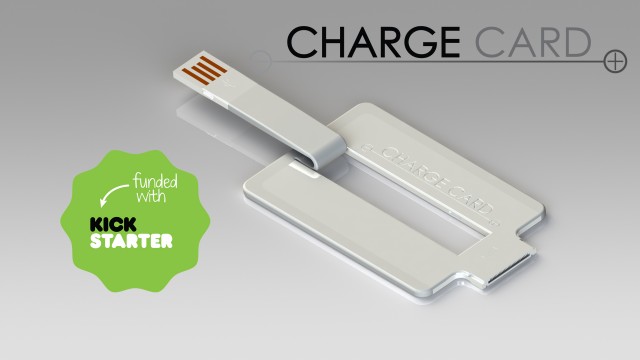
The growing number of mobile-related projects funded on Kickstarter is fantastic for the industry. While Pebble got all the press and Chameleon all the buzz, ChargeCard has been slowly adding backers — 3600+ and counting, with over $104,000 pledged — for its wallet-sized iPhone and Android charger.
The idea is pretty simple: how often have you been caught with no charger minutes before your smartphone battery dies? Often all you have with you is a wallet, keys and a smartphone — really all you need to get through the day. But when that phone dies, having nothing to charge it with is a pain in the neck. ChargeCard founders Noah Dentzel and Adam Miller had the idea to create a wallet-sized smartphone charger that wouldn’t look out of place next to a credit or debit card.
Due to the relative thinness of Apple’s 30-pin dock connector, and the ubiquity of the USB- and microUSB ports, it only took a few steps to turn an idea into a viable product. Kickstarter, as it is wont to do, has enabled the rest. There is also an Android-compatible version in the works that uses the microUSB standard, and other iterations are inevitable if ChargeCard is successful. The simplicity of the idea is what strikes me as so potentially powerful: few other ideas have been translated into such a slick and versatile design.
I had a chance to chat with Noah, who explained to me his reasons, methods and desires for ChargeCard.
1) Where did the idea come from for the ChargeCard?
In my first job after college, I worked in a technology company and we were all Blackberry addicts. When we’d go out on the town, our phones always seemed to be dying on us which naturally caused a lot of frustration. So I began pushing around the idea of a tiny micro USB to USB connector, something portable enough to always have on you. But then a friend who was working with SIM cards in the mobile division of our company mentioned that shaping the device in the form-factor of a credit card would allow the user to always have it on them. The idea stuck.
2) So you had an idea, but how did you actually bring it to life?
Great question! I was lucky to meet a genuinely talented and motivated industrial designer, co-founder Adam Miller, who saw the vision and recognized the potential. Team is key for taking ideas to the next level.
3) Why did you choose to use Kickstarter over seeking Venture capital?
The Kickstarter platform is as brilliant as the projects that launch on it. Kickstarter allows entrepreneurs to gauge market response for their product before committing to costly tooling and manufacturing, which in our case run tens of thousands of dollars — quite a stretch for a couple of recent college grads. We considered the options of taking on more traditional financing, but we were excited to be part of this new movement. Much the way venture capital changed startup financing 50 years ago, crowdfunding sites like Kickstarter are once more changing the way finance works. It’s no longer necessary to seek the funding (and control) that comes from angel investors and venture capital (VC) firms now that the general public can take part in supporting and financing new products and creative projects. After all, the fun of investing in cool creative projects should be open to all.

4) What has the experience been like so far on Kickstarter?
Hectic, exhilarating, and–when I’m not stressing out over something–fun, too! As anyone running a project or starting a business will tell you, you’ll have to wear many hats throughout the course of the day. There is no marketing department, sales team or customer support group, it’s all you. It’s an MBA crash course or perhaps something more considering that we’re spanning the gamut of product design and development, manufacturing, marketing and, of course, delivering the product.
5) Keys, phone, wallet: the only three things you should remember. Does ChargeCard plan to use that as a tagline?
It’s definitely an operational one at the moment and it really showcases our vision. The core aspect of our innovation here is that by being so portable, we’re not just another gadget you have to remember to carry on you, rather, we actually fit neatly into something you’ve already got on you, your wallet. ChargeCard aims to fit into your life so it’s there when you need it.
6) How do you plan to adapt the project if Apple changes the design of the iPhone dock in the coming version?
A lot of people awaiting the new iPhone with the rumored 19-pin connector have messaged us about this. We’re eagerly awaiting to develop for the future connector once Apple releases its specifications. For now though, ChargeCard works on the over 200 million iPhones sold to date, including the many hundreds of millions of iPods (and let’s not forget iPads, too!). We’ll also shortly be releasing the Android design and we’re happy to note that there are no rumors at the moment about a redesign with the current micro USB connector.

7) Is $20 the sweet spot for a product like this?
$20 is an easy number for people to wrap their heads around, and it’s comparable to the price of other cables and portable connectors. Of course $20 also reflects a fair price based on our development, manufacturing and distribution costs, too.
8) Do you plan to seek Apple’s help in selling the product, or perhaps move to a retail model for the ChargeCard such as Best Buy?
Right now we’re focused on our first delivery for our Kickstarter backers. Later, though, we look to retail in more outlets, both on and offline.
—
For more information on ChargeCard, or to pledge an amount, head on over to Kickstarter.
MobileSyrup may earn a commission from purchases made via our links, which helps fund the journalism we provide free on our website. These links do not influence our editorial content. Support us here.


